Text
Toop/Marclay talking about Sonic Boom (2000)
youtube
juxtaposing two sound pieces (one noisy one delicate) tgt.
so people decided to listen to it closely
0 notes
Text
http://www.rienakajima.com/Sculpture/about.html
Sculpture is an event devised and curated by Rie Nakajima and David Toop. Any event that defines itself from the environment and within time is a Sculpture. The participants may be musicians, artists, performers, writers or anybody who has something they can present. The guidelines for the format are simple.
1. You can place your Sculpture in any part of the space except for those that are forbidden by external forces.
2. Please choose the duration of your Sculpture. This can be approximate for your own purposes but please be specific when you tell us the duration.
3. If your Sculpture lasts for longer than the time you have chosen then you may find that the next Sculpture overlaps with yours. Please don’t be alarmed by this.
In their conversation for OTO Broadcast on Resonance FM, 2013, Rie Nakajima and David Toop talked about events as sculpture, the duration of objects and the weight of actions. Sculpture is an experience that proposes a strategy, working to subvert the routines of performance as entertainment, lecture as information, literature fixed to the page, the conventions of duration, the direction of light and occupation of a space. Does the sculptor have to be present, or make things? Always end with a question? Sculpture has been presented since 2013. The participating artists have included Angharad Davies, Daniela Cascella, Pierre Berthet, Charles Hayward, Max Eastley, Emi Watanabe, Lina Lapelyte, Marie Roux, David Cunningham, John Butcher and many others.
0 notes
Text
reflection: workshop with Kara
Initial plan:
Improvisation sessions with my flatmate Kara who has no previous experience in sound or dance. During the session, Kara will record with a Zoom. Our interaction will allow her to explore the relationship between performing bodies and spatial acoustics.
Initial goal:
To add spatial quality to my object based improvisational sounds which can be interesting material for the composition of the second project, as well as reinforcing the collaborative aspect. (collecting sounds)
Thoughts:
1. Is it about collecting sounds? Role of listening / listening training in workshop.
2. This experience allows me to critique my own practice when responding to technical limitations. The amplification of my quiet sounds has been always present in other improvisation sessions. It is way more demanding - without technology “helps” me to listen. Am I a bit disappointed listening to the recording? Will amplification make it easier for the crowd / participants who has no prior experience with sound to understand sound?
3. “collective spontaneity” My role has changed, the goal is not about making the perfect sound, but how can I communicate with someone who has no previous listening training through sound. Being aware of this, the performance is more “improvised” than ever because the expectation is changed.
0 notes
Text
About Lactose Intolerance
Another study found that while only 38.5% of Chinese children ages 3-5 years old were lactase-deficient, 87% of those in the 7-8 year and 11-13 year old groups were. In some East Asian communities, up to 90% of adults are lactose-intolerant, according to the US National Library of Medicine.
-
[D]rinking milk is increasingly viewed as healthy—especially for kids—and has caught on with an increasingly affluent middle class,” Food Safety News noted in December.
-
And Beijing has been spurring the drive for dairy. “I have a dream to provide every Chinese, especially children, sufficient milk each day,” Chinese premier Wen Jiabao said in 2007. The country is on track to meet that goal, apparently even if it makes them sick.
-
Lactase concentrations in the body are the greatest at birth and rapidly decline after weaning such that the majority of adults would be lactase deficient. Published studies in Chinese and Japanese patients have shown a steady decline in lactase activity in children with increasing age.3, 4, 5 The timing and rate of decline is genetically determined8 and varies between individuals and ethnic groups. It has been shown in Western populations that lactase activity persists into adulthood.9
-
Compared to the countries which benefit more from sunlight by being near the equator, northern European countries needed to consume more milk to obtain more calcium since they lack Vitamin D from the sun.
This is why lactose intolerance rates among northern Europeans can go as low as 5% of adults while in some Asian communities, it can go as high as over 90%.
0 notes
Text
https://www.tptranscription.co.uk/jefferson-transcription-example/
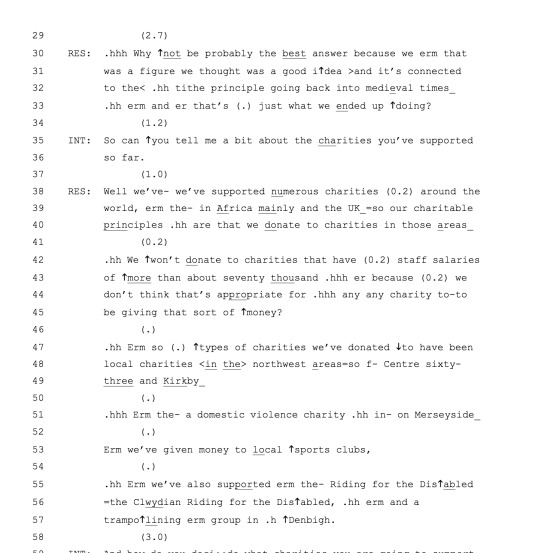
0 notes
Photo

Narrative framing: defamiliarizing the narrative act
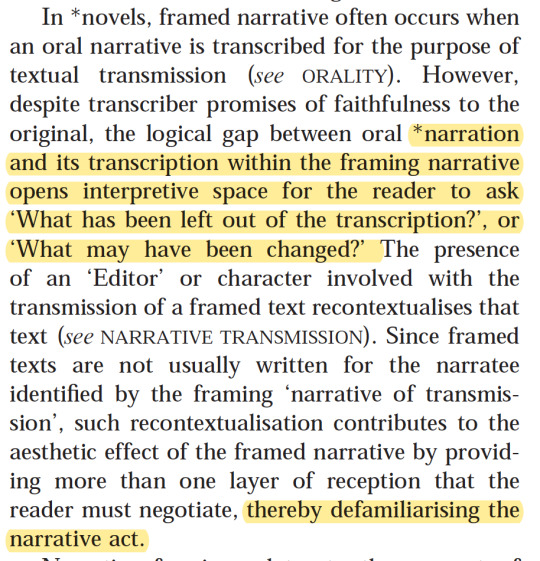
0 notes
Link

March Res./ Gameplay.2
An excellent example of text-based interactive fiction.
The player engage with the conversations happening between a yokai (ghost in Japanese folklore) hitchhiker and taxi drivers, the narrative is based on a historical event - Kaito earthquake in 1923. From the conversations, the player gets to know more and more information. However, inevitably, there are parts of the conversations are repetitive. What’s great about the design it’s the right amount of impatience the player will get when reading the same info, which echoes with the character’s impatience.
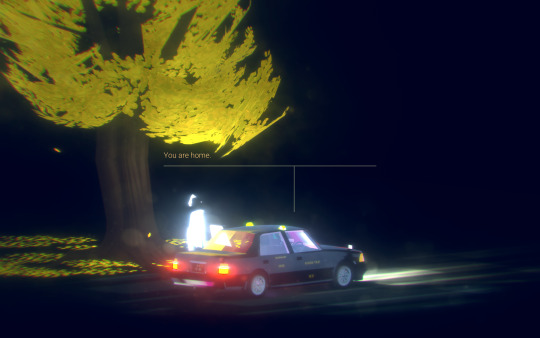
The visual is mostly made of loops, however, enough to creates a space that invites the player in. It’s a very strong piece in terms of visual and text writing however, hearing the same soundtrack for 45-60 mins can be a bit exhausting. But maybe the player also needs the looping music as well and it’s part of the repetitiveness. I don't think there is actually anything I want to change the game experience for Bird of Passage.

Conceptually, there is a lot of space to explore sound design for text-based interactive games. What makes a character interesting and how sonic details/presence reveals a character?
(text-empathy, emotion and narrative)

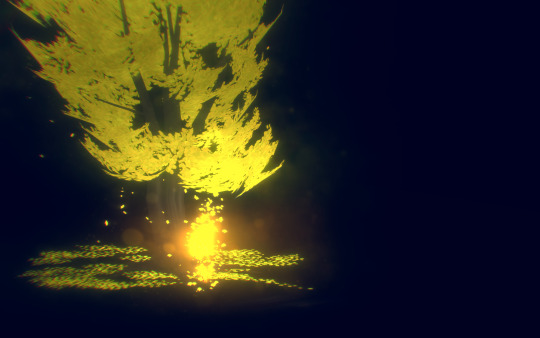
Film viewing vs. textual narrative:

0 notes
Text
constructing game / notes
[general mechanism]
an around 8-10 min interactive visual/sonic novel without too much interaction.
The player will control the character to move around using arrow/WASD keys.
The character is "invisible": when the character is in movement (walking, running), the player can only sense the sonic presence (footstep, heavy breathing etc.) of the character. When the character stops (sit/lie down), the player can no longer sense its sonic presence, instead, having the attention on the sonic environment.
In addition, when the character stops, its "visibility" is reflected/represented by textual conversation (written words translated directly from speech- text translation program*/Jefferson Transcription System). In this way, the player can either access the character via sonic or "visual" presence, but not both at the same time. The player is in between the situation of "becoming the fictional character" and "becoming the player themselves (the second character) who is having a conversation with the fictional character".
*[text/"visual" presence]
The text element is available when the character is sitting, and when the player "takes away" the sitting the player also takes away access to that textual relationship with the character. I guess in someway I am also exploring the sonic aspect of written text and how text can convey emotional expression through colloquial vocabs, spelling mistakes, grammatical errors, space between words etc. (thinking about the intimate moments of two people editing the same text on google doc at the same time)
0 notes
Photo


Doodle/ experimenting with Jefferson Transcription System to create small scenes/ narrative
0 notes
Link
March Res./ Gameplay 1.
Few reviews mentioned “digital art installation” to describe this game.
There are 10 scenes in sequence. The player can control the camera to wheel around the scene and gain new perspectives. The player can also click on light objects to trigger movements and sounds.
In one scene the player click and trigger an unseen businessman’s evening routing, peeking through the window gap, “directing” him to park his car, go upstairs, turn on tv, brush his teeth, switch off light. The design of the perspective is interesting here, as it creates both intimacy and distance. The use of sonic presence without visual image of the character works really well with the gloomy, dusky atmosphere.
In audio, Islands’s soundscape is a collage of unexpected elements (eg. hotel + rainforest) to evoke unfamiliarity within the familiar daily objects/scenes. There’s very little interaction here and there’s no trophy or winning. The minimalist visual aesthetic left a lot of space for the player’s attention to focus on soundscape while still provide enough information to create an atmosphere through remixing visual spaces.
I think 45 mins is a good amount of time.
youtube
0 notes
Text
Ref:
Noam Chomsky, writing as a taught skills - a technology that is different from speech (innate ability of human)
0 notes
Photo
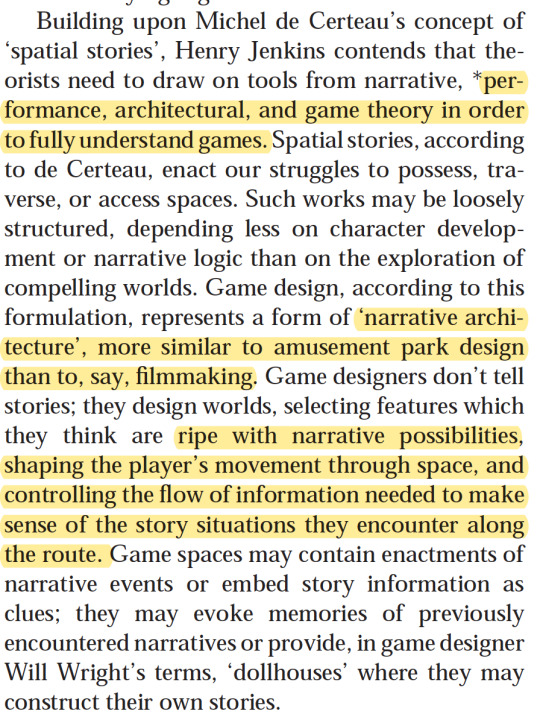
Narrative architecture / game design as interdisciplinary practice
0 notes
Link
0 notes




